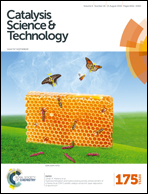Immobilization of O-acetylserine sulfhydrylase as a highly active and recyclable nanobiocatalyst: efficient synthesis of β-pyrazol-1-yl-l-alanine†
Abstract
O-Acetylserine sulfhydrylase (OASS) was immobilized for the first time as an active and recyclable biocatalyst for the conversion of O-acetyl-L-serine (OAS) with a nucleophile to the corresponding useful and valuable β-substituted L-α-amino acid. The simple and efficient immobilization was achieved via affinity attachment, without costly enzyme purification, by direct treatment of cell free extracts (CFE) of a recombinant Escherichia coli strain expressing His-tagged OASS isozyme CysK or CysM with Ni-NTA functionalized iron oxide magnetic nanoparticles. The obtained nanobiocatalysts His-CysK-MNPs (85 nm) and His-CysM-MNPs (85 nm) showed high specific enzyme loading (150 and 94 mg of protein per g of MNPs, respectively) and enzyme loading efficiency (80 and 100%, respectively) and catalyzed the conversion of OAS and pyrazole to β-pyrazol-1-yl-L-alanine (β-PA) with the full activity (2.3 and 1.7 U mg−1 of protein, respectively) of the corresponding free enzyme. His-CysK-MNPs and His-CysM-MNPs were easily separated under magnetic field and demonstrated good recyclability with the retaining of 57% and 54% productivity in the 10th cycle, respectively. Pretreatment of the nanobiocatalysts with 50 mM β-PA released some weakly bound proteins and improved catalyst stability and recyclability. The pretreated His-CysK-MNPs catalyzed the conversion of OAS and pyrazole to produce 1080 mM β-PA with 60% overall conversion over 20 reaction cycles and retained 62% productivity in the 20th cycle. These results indicate the efficient synthesis of the useful and valuable β-PA, and the immobilized OASS could be useful for the synthesis of other β-substituted L-α-amino acids.


 Please wait while we load your content...
Please wait while we load your content...